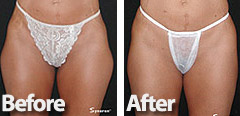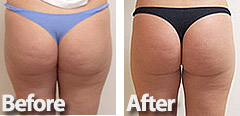VelaShape is a new FDA approved device which has been shown to reduce the appearance of cellulite and decrease the circumference of the thigh without surgery or needles. This body contouring device uses bipolar radiofrequency energy to reduce the size of the fat cells and utilizes infrared heat to tighten the skin. A somewhat similar device was used earlier, yet the VelaShape provides about 10 times more power than its earlier model.
Who is a candidate for VelaShape?
Anyone who has dimpled skin or cellulite and isolated pockets of fat can be candidates for the procedure. Since the device can work on many body areas, the uses are almost limitless. If one wants to reduce a pant size, then treatments of the abdomen, upper thigh, and hips are recommended. If one wants to just target cellulite on the back of the legs it can be done as an isolated and customized area. Tighter arms and in some cases, double chins can be treated effectively. Bra lines, love handles, saddlebags, etc. are also popular areas for the VelaShape.
What does the procedure feel like?
The VelaShape feels like deep heat and massage. The device will lift tissues with suction and vacuum, and then target these tissues with infrared and bipolar radiofrequency energies to reduce fat cell volume and tighten skin. Most patients find the procedure very tolerable and can be relaxing.
How many treatments do I need?
Although results can be seen after 4 treatments, it is advised that 6 treatments over 6 weeks be done initially. Thereafter, one’s lifestyle can make a huge difference on the need for maintenance treatments. If one watches their diet and gets regular exercise, then a treatment every 3 months may be all that is needed. However, inactive lifestyles and over-indulging could mean that a monthly maintenance is required.
Is VelaShape a permanent cure for cellulite?
No, presently we have no cure for cellulite, but this technology seems to be one of the easiest and fastest methods of showing improvement than other means available on the market today and, the procedure is non-invasive with no needles or incisions necessary.
Are there any side effects of the treatments?
Some people may experience some mild bruising which is temporary. If a patient is on anti-coagulants, they should not undergo treatments as this procedure can increase blood flow to an area. Temporary redness and increased heat can be experienced in the treated areas for about one hour.
How soon will one see results?
Doctors are reporting results in as little as 4 weeks. Treatments of the abdomen, love handles, buttocks and possibly hips can result in a reduced pant size in as little as one month.
How much is done in one session?
It is advised that each session be limited to no more than 40 minutes. Any given AREA is treated for a total of 10 minutes, and the areas are fully decided upon at the first consultation. Consultations are a necessity, because the treatments are completely customized, and everyone has a different body shape. Therefore, your choices for targeted areas are unlimited and tailored to your specific needs.
What is the approximate cost of treatments?
Since the areas to be treated are customized, it is advised to discuss this fully at the first consultation. In general, to reduce thigh circumference, two separate sessions will be required for a total treatment time of 80 minutes. The total thigh treatment will cost approximately $1300 on an average size person. Plan on 6 initial treatments followed by maintenance treatments as discussed above. However, if only the back of the upper thighs are treated for cellulite, then each session is approximately 20 minutes and would cost $320. Packages may be offered, so it is best to check with your healthcare provider for different pricing options.
Before and Afters


Disclaimer: This information is intended only as an introduction to this procedure. This information should not be used to determine whether you will have the procedure performed nor does it guarantee results of your elective surgery. Further details regarding surgical standards and procedures should be discussed with your physician.
By Dermanetwork.org Staff
Updated: October 29, 2009


